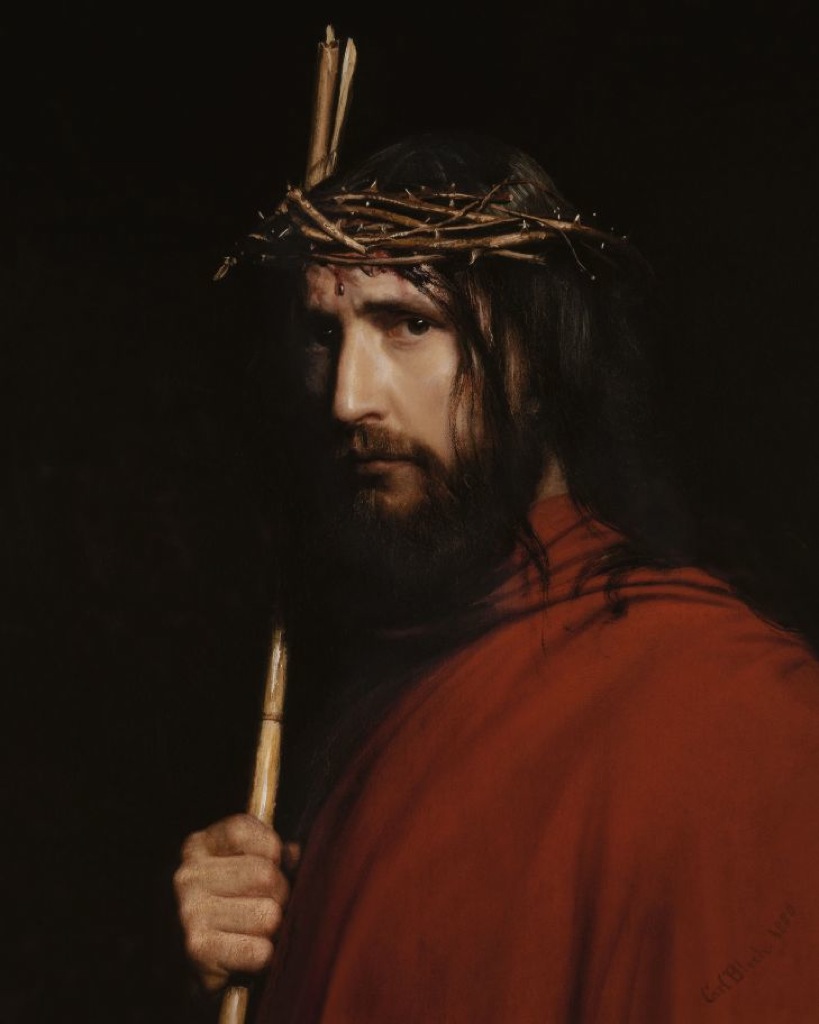 by Theresa Cavicchio
by Theresa CavicchioThe final days of Lent call us to reflect more deeply on the Sorrowful Mysteries – key scenes in the climax of Jesus’ earthly life from Holy Thursday night through the Friday we call Good. As Pope Saint John Paul II writes, “the Rosary selects certain moments from the Passion, inviting the faithful to contemplate them in their hearts and to relive them” (Rosarium Virginis Mariae, 22).
It is right and proper to center our attention on Jesus Himself through those dark hours. However, we can expand our focus to include other persons whom Scripture places in the five scenes – minor players, so to speak – shifting them into the foreground, as follows.
The Agony in the Garden ~ Judas Iscariot Mt 26:36 - 50; Mk 14:32 - 45; Lk 22:39 – 48
Jesus takes His final steps as a free man, into the Garden of Gethsemane, to lose Himself in anguished prayer of submission to the Father’s will. The first drops of Precious Blood are shed as, overcome with sorrow and dread, Jesus engages evil in battle. Then Judas Iscariot, one of the chosen twelve, appears on the scene, leading an armed band of soldiers and Temple personnel. He bestows the kiss of treachery which brands him for all time as infamy and betrayal personified, as Jesus is arrested.
For reflection: “Judas’ restless heart is tormented by concupiscence and tormented by the love of Jesus - a love that failed to become love. Tormented by this fog, he goes back to the priests and asks for forgiveness, asks for salvation. ‘What is that to us? It is your responsibility…’ (see Mt 27:4). The devil speaks like this and leaves us in despair” (Pope Francis homily, Wednesday of Holy Week, 2020).
The Scourging at the Pillar ~ Barabbas Mt 27:15-26; Mk 15:6-15; Lk 23:18-25; Jn 18:39-19:1
Pilate vacillates, and the innocent Son of the Father God is handed over for flogging and crucifixion. The common criminal – described by turns as a notorious prisoner, insurrectionist, murderer, and bandit – goes free. In an ironic twist to this incongruity, the name Barabbas translates to son of the father.
For reflection: “As often as I choose to speak the uncharitable word, do the dishonest action, or consent to the evil thought, I say in so many words, ‘Release unto me Barabbas,’ and to choose Barabbas means to crucify Christ” (The Way of the Cross, Venerable Archbishop Fulton Sheen).The Crowning with Thorns ~ The One Who Fashions It Mt 27:29; Mk 15:17; Jn 19:2
The anonymous person who constructs the crown of thorns forms an instrument of torture and ridicule for God’s own Son. The crowning is only one aspect of the abject cruelty heaped upon Jesus by the jeering crowd humiliating and mocking Him. The reed scepter, the purple garment, and the thorny crown inflict pain on Him, the only true King, on many different levels: physical, psychological, and emotional.
For reflection: “Christ allowed Himself to be mocked, spat upon, slapped and crowned with thorns that we might realize with Him and like Him that the Kingdom for which we were created, and for which He underwent His Passion … [is] the Kingdom of Heaven!” (Archives, Servant of God John A. Hardon).
The Carrying of the Cross ~ Simon of Cyrene Mt 27:32; Mk 15:21; Lk 23:26
The synoptic Gospels describe Simon of Cyrene as an unwitting passer-by compelled to submit to the demand of impatient guards. Grudgingly, he takes up the cross behind Jesus, and we are left to ponder: as the torturous procession of ignominy crawls forward, is Simon’s heart touched – then, or later, in retrospect? Does he experience a Good Friday conversion?
For reflection: “Fearing that [Jesus] would die on the way when they wished Him to die the infamous death of the cross, they forced Simon of Cyrene to help carry the cross after Our Lord” (Stations of the Cross, Saint Alphonsus Liguori).
The Crucifixion ~ Joseph of Arimathea Mt 27:57 – 60; Mk 15:42 – 46; Lk 23:50 – 53; Jn 19:38 – 42
Joseph of Arimathea is a wealthy man with considerable standing in the Jewish hierarchy, a secret follower of Jesus. The unspeakable injustice he witnesses on Calvary, however, spurs him to approach Pilate with courage, disregarding the potential cost to his status and reputation. This final “minor player” provides the resting place for the brutalized, bloodied Body of the Son of God, the very place where – in just a few days’ time – ignominy will become glory.
For reflection: “Now there was a virtuous and righteous man named Joseph who, though he was a member of the council, had not consented to their plan of action … He went to Pilate and asked for the body of Jesus. After he had taken the body down, he wrapped it in a linen cloth and laid him in a rock-hewn tomb in which no one had yet been buried” (Lk 23:50 – 53).
Conclusion While viewing the roles of these “minor players” through a wider lens can broaden our perspective of Jesus’ final hours on earth, we turn to Our Lady as a major player – a tragic thread running through the tapestry of the Sorrowful Mysteries. Tugging at our hearts, she stands steadfast beneath the Cross of her Son, her soul pierced at each agonized breath until the final one.
Bishop Robert Barron’s commentary focuses our attention on the ultimate heart-wrenching scene: “the Pieta depiction at the very end, where Mary is holding the lifeless body of Jesus. There we see Mary’s role: to present the sacrifice of her son to us and for us.”
During these holiest of days, we pray for Our Lady’s help to embrace that sacrifice with open arms and grateful hearts overflowing with love.
© All Rights Reserved, Living His Life Abundantly®/Women of Grace® http://www.womenofgrace.com
